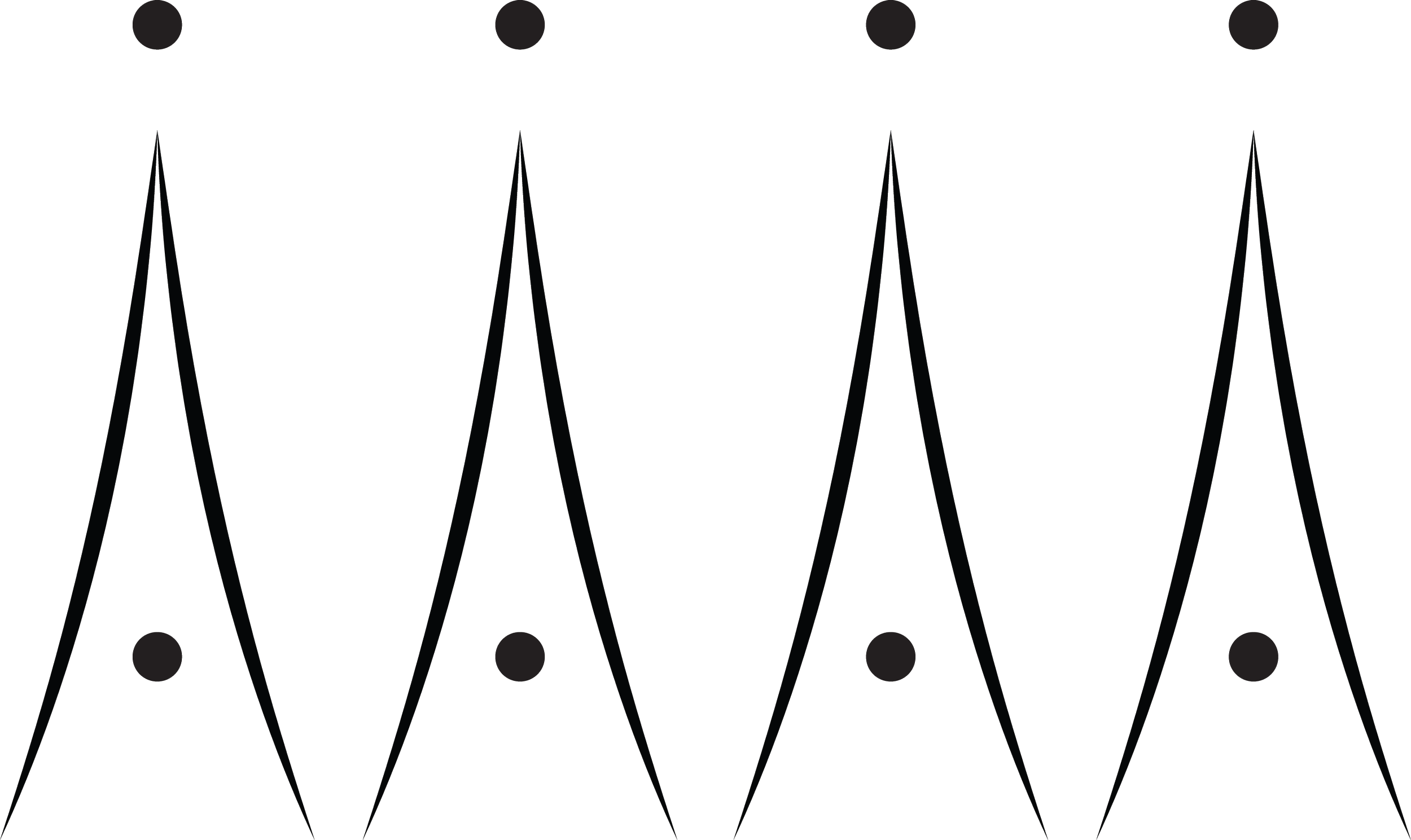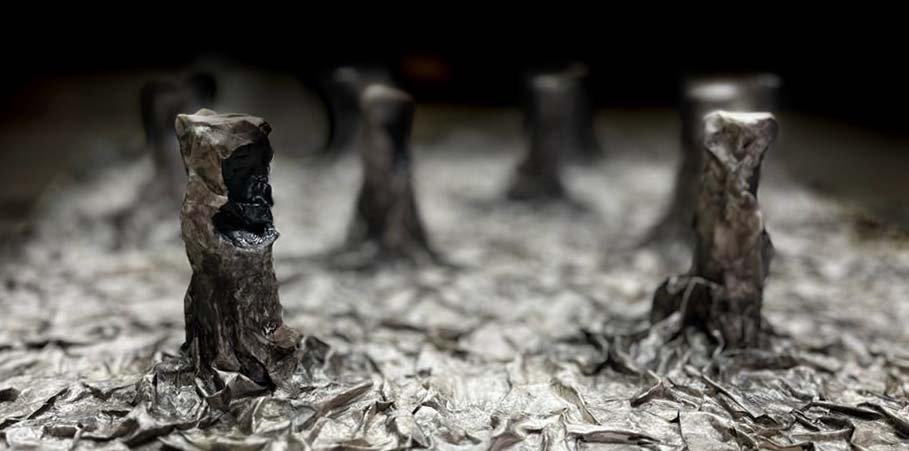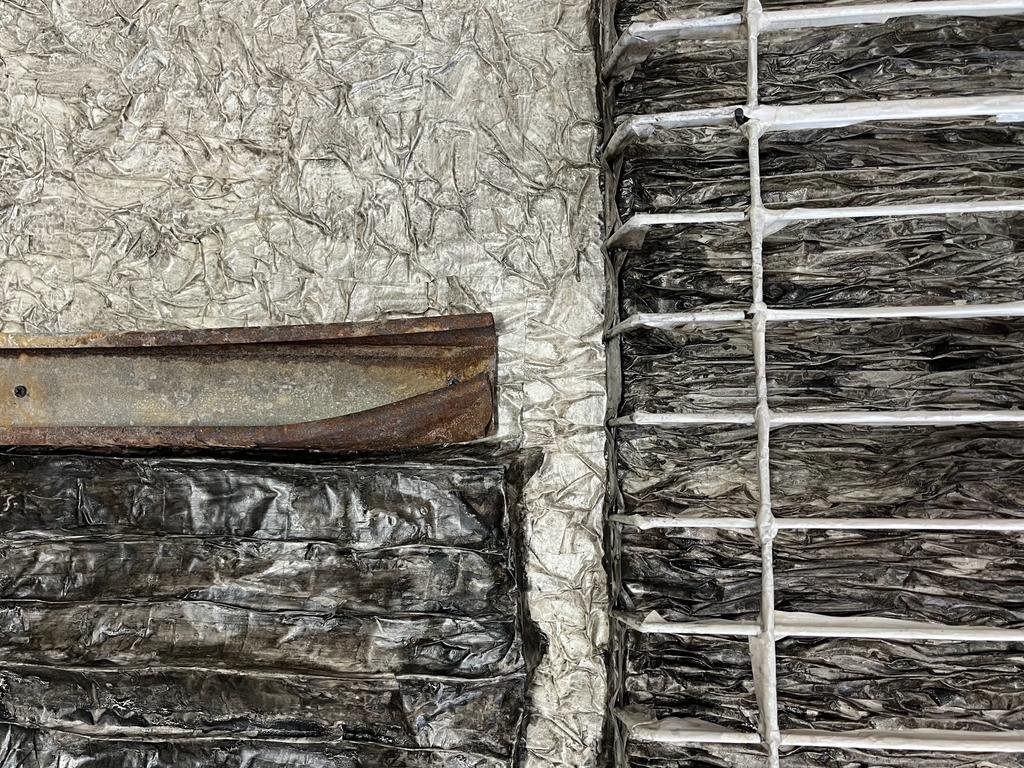46 Renacimientos
46 Renacimientos is an art project by Alvaro Alvarez consisting of forty-six sculptural paintings, each corresponding to one of the forty-six abandoned projects down the coast of Baja. Each of these physical art pieces behave as an altar that houses the architectural soul of the building, giving it a place to rest and celebrate its second life. The altars are created using abandoned in a warehouse in San Ysidro, CA. A wood panel is the base for an arrangement of metal and plastic creating the structure underneath the paper layers, all embraced by black gesso and ink on top. Each altar’s geometrical composition emulates the architectural typology of the COCOTREN project it is representing. COCOTREN is an acronym for Coastal Corridor Tijuana-Rosarito-Ensenada, and it is 90 miles of highway connecting the three cities alongside the Pacific Ocean coast. Throughout this corridor, 46 construction projects were halted in 2008 due to the recession and remained abandoned for 15 years.
46 Renacimientos es un proyecto del artista Arq. Alvaro Andres Alvarez Bustamante, y la empresa Bustamante Business Center del Sr. Luis Bustamante Fernandez, presentando cuarenta y seis obras de arte escultural, texturizadas con papel y pintadas de negro - cada una de estas obras representando uno de los cuarenta y seis desarrollos inmobiliarios alguna vez abandonados en los 145 kilometros de costa de Baja California, Mexico, y que ahora son re-desarrollados, celebrando una segunda vida en el COCOTREN (Corredor Costero Tijuana Rosarito Ensenada). El COCOTREN es un tramo de 145 kilómetros que recorre las tres ciudades Baja Californianas. En este corredor se construían cuarenta y seis inmuebles residenciales de gran escala a principios de este milenio, y todos fueron detenidos en el 2008 debido a la recesión financiera, dejando abandonadas sus estructuras en la playa.
Unlike the prolonged, silent death experienced by the COCOTREN properties since 2008, this celebration of 46 Renacimientos will be striking and thoroughly documented. Every time a society such as ours undergoes a positive transformation, it is detrimental to dismiss it as a quotidian banality. Instead, it is very important to create a cultural record that captures this architectural uprising, telling our story with excitement through the universal language of art.
46 Renacimientos aspires to contribute towards that cultural record, engaging the neighbors and residents of Baja California in a serious conversation by inquiring: Why did we accept the abandonment of these forty-six projects as our new reality? What do these empty shells mean to us now? Drivers on the Tijuana-Ensenada scenic highway, considered the most beautiful in Mexico, usually just pass by these forgotten buildings, leaving them behind in the rearview mirror. Only the neighbors and commutters see them daily. By creating these altars to the COCOTREN, we can slow down and carefully observe each work, understanding them both independently and as part of an architectural ensemble. 46 Renacimientos attempts to provide dignity and respect to these forty-six developments, so that they are no longer just skeletons on the beach.
The art pieces in 46 Renacimientos were made using previously abandoned materials (wood, metal, paper) similarly discarded in a San Ysidro warehouse. These are now offered a new usage, minimizing environmental impact. Through the assemblage of these materials, 46 Renacimientos connect us with our Mexican tradition of “cartonería” as a manufacturing method. By using this ancestral technique, also known as Papier-mâché, the layers of paper glued on top of each other connect the different pieces underneath each sculpture.
The relationship between the light and darkness created by the material planes of each sculpture is itself what provides the color: a thick dark layer tattoos the shell beneath the paper, in the same way that a sheet delicately covers a carcass. The black reflection of the heavy gesso along with the thinness of the ink organize the remains that live below the surface through pictorial coordinates. Each of the forty-six altars has been created with this monochrome uniform to unify and strengthen their collective message, without compromising the original personality of each three-dimensional work.
Architecture plays the leading role in this chronicle due to how its rigor and processes create a physical manifestation of the soul and spirit of both the properties on the coast and the altars that represent them. Concurrently, texture also has a very important function in this visual narrative, since it is the skin of the architectural spirit being represented. The geographical relief of each altar creates its own landscape on top of each wooden board, using black painted on stretched, folded, and pinched paper, confluencing the softness and fluidity of the paper covering the plastic pieces with the more defined features of the hardware and metal components underneath. All of this contributes to the topographic constitution of each sculpture.
A diferencia de la larga y silenciosa muerte que experimentaron los inmuebles del COCOTREN, esta celebración de 46 Renacimientos será fuerte y exhaustivamente documentada. Cada vez que una sociedad como la nuestra atraviesa una transformación positiva, es detrimental el dejarla pasar como algo banal o cotidiano. En vez, es muy importante crear un registro cultural que capture este levantamiento arquitectónico, relatando esta historia por medio del lenguaje universal del arte.
46 Renacimientos aspira a ser ese registro cultural, involucrando a los vecinos y residentes de Baja California en una conversación seria al preguntar: ¿Porque hemos aceptado el desamparo de estos cuarenta y seis proyectos como nuestra nueva realidad? ¿Qué significan estos caparazones vacíos para nosotros ahora? Conductores en la carretera escénica Tijuana-Ensenada, considerada la más hermosa de México, usualmente solo pasan estas construcciones abandonadas en su coche, dejándolas atrás por el retrovisor. Únicamente los vecinos las ven todos los días. Al crear estos altares al COCOTREN, podemos desacelerar y observar con atención cada obra, tanto independientemente al igual que como parte de un conjunto arquitectónico. 46 Renacimientos intenta proveerles dignidad y respeto a estos cuarenta y seis desarrollos, para que ya no sean solamente esqueletos en la playa.
Las piezas de arte en 46 Renacimientos fueron fabricadas utilizando instrumentos previamente abandonados en una bodega de San Ysidro; similarmente ofreciendo también una nueva vida a estos materiales (maderas, metal, papel), y evitando el tener que adquirir componentes nuevos, minimizando el impacto al medio ambiente. Vinculando este esfuerzo artístico, 46 Renacimientos se conecta con nuestra tradición Mexicana de “cartonería” como método de fabricación. Al utilizar esta técnica tradicional, también conocida como papel maché, las capas de papel pegadas una encima de la otra conectan las diferentes piezas de cada escultura, y se vinculan con una costumbre artística ancestral.
La conversación entre luz y sombra creada por los planos materiales de cada escultura es en sí lo que provee el color: una capa gruesa oscura tatúa la coraza debajo del papel, de la misma forma que una sábana cubre delicadamente una carcasa. El reflejante negro del pesado yeso junto con la delgadez de la tinta nos demuestran los restos que habitan por debajo de la superficie, creando coordinadas pictoricas. Cada unos de los cuarenta y seis altares ha sido creado con este uniforme monocromático para unificar su mensaje colectivo, sin comprometer el carácter original de cada obra presentada tridimensionalmente.
La arquitectura desempeña el papel protagonista de esta crónica, ya que gracias a su rigor y procesos, podemos crear una manifestación física del alma y espíritu, tanto de los inmuebles en la costa, como los altares que los representan. Simultáneamente, la textura tiene también una función muy importante en esta narrativa visual, ya que es la piel del espíritu arquitectónico siendo representado. El relieve geográfico de cada altar, armado con capas de múltiples materiales, crea su propio paisaje encima de cada tabla de madera, utilizando tinta pintada sobre papel arrugado, doblado, y pellizcado. Son dos personalidades las que se convergen sobre la base de madera: la suavidad y fluidez del papel sobre piezas de plástico, junto con los rasgos más definidos por las piezas de herradura y metal que están debajo, contribuyendo a la constitución topográfica de cada escultura.



